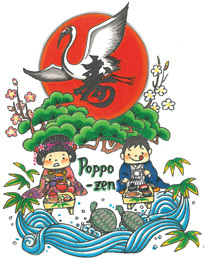Hakata Culture vol.24
Shichi-go-san and Poppo-zen

The shichi-go-san festival takes place on November 15th and honors the Japanese custom of celebrating a child’s growth at the ages of three, five, and seven. On that day you’ll see formally dressed children with their parents and grandparents at most Shinto shrines throughout the country. The festival began as a custom in samurai families during the Edo period, but it became more widespread after the Meiji period.
Here in the commercial district of Hakata, it is customary to hold the o-zen suwari, during which an auspicious day is chosen for three-year olds to select their own food for the first time. Until that date, the children are served food by their parents. On this day, however, the children use chopsticks and take meals on their own. Traditional trays are called zen, and the smaller trays for children are called poppo zen. These are cute square trays made of unfinished wood, to which legs are attached. They are decorated with propitious designs, such as pine, bamboo, and plum, as well as cranes and tortoises. The word poppo represents the crane, as young children first learning how to speak refer to birds as poppo.
The poppo zen are one of the Hakata magemono, a famous local product made in the Maidashi district of Higashi Ward in Fukuoka City. Thin strips of cedar and cypress are placed in hot water to soften them, and then the wood is shaped and bound with the bark of a cherry tree. This woodworking art is said to have developed to make festival implements formally used at the Hakozaki-miya shrine near Maidashi. It later came to be used to make items for the home, including rice tubs and bento boxes. It is still a popular folk handicraft, though items made in this way are rather expensive.
The foods served in the poppo zen are indispensable for this celebrations, including red beans and rice, namasu (a raw fish, vinegar, and vegetable salad with daikon and carrots) and whole fish. The rice bowls are lacquerware; those for boys are black on the outside and crimson on the inside, while those for girls are crimson inside and out.
This custom is still practiced in some old commercial families today. In the past, parents used the poppo zen to teach their children table manners, how to use chopsticks, and how to remove the bones from fish.
Another shichi-go-san custom is the confection known as chitose ame. The long candy represents the parents’ wish for a long life for their child. Today, the people at Hello Kitty make many different varieties of chitose ame.
A public relations manager
Kimiyo Sasaki
七五三とポッポ膳
11月15日は七五三。日本では3歳、5歳、7歳という節目に子どもの成長をお祝いする風習があります。全国各地の神社で、正装した子どもたちとお父さん、お母さん、おじいちゃん、おばあちゃんがお参りしている姿を見ることができるはず。もともとは江戸時代の武家に伝わる風習のようですが、全国に広まったのは明治以降とか。
ここ商人の町・博多でも子どもが3歳になると吉日を選んで「お膳すわりの祝い」が行われ、それまでは親の食べ物をもらっていたのが、3歳で初めて自分の膳が与えられ、箸を使って正式な食事を取り始めるというものです。そのお膳が「ポッポ膳」という子ども用の小さなお膳。ポッポ膳は白木の四角い足つきお膳に、目出度い図柄の松竹梅と鶴亀が描かれている可愛らしいもの。ポッポは鶴のことで、鳥をポッポと呼ぶ幼児語が由来です。
ポッポ膳は福岡市東区馬出で作られている博多の名産「博多曲物」で、スギやヒノキの薄い板を熱湯につけて柔らかくして成型し、桜の樹皮で綴じて作られます。馬出の近くにある筥崎宮の儀式に使われる祭具として発展してきた木工芸品といわれます。ご飯を入れるお櫃や弁当箱など生活用品としても使われてきました。今でも民芸品として人気で、櫛田神社前の「博多町家」ふるさと館などで購入できます。
ポッポ膳に置かれる食べ物は、お祝い事に欠かせない小豆ご飯、ダイコンとニンジンのなます、それに尾頭付きの魚。お茶碗も男の子用は外側が黒、内側が朱色、女の子用は外側も内側も朱色の漆の器だったそうです。今でも古い商家にはこんな儀式が残っているかもしれません。子どもたちはこのポッポ膳を前にして食べ方のマナーや箸の使い方、骨の取り方などを親から教わったといいます。
七五三といえば、千歳飴。長~い飴で親が子どもの長寿を願ったもの。今ではキティちゃんの千歳飴など多種多様な商品が作られているようです。
福岡市広報課長 佐々木 喜美代

